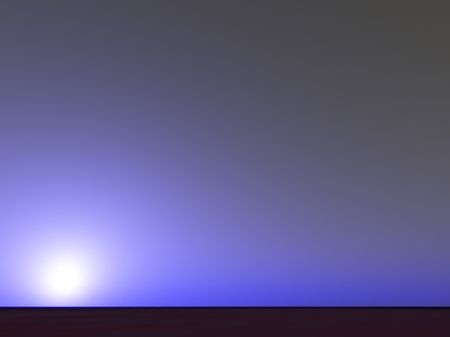
I’ve done some initial color tests for the atmosphere and terrain. I wanted to see what a yellow atmosphere with a blue star would look like and how the atmospheric scattering would effect red colored plant life. The sunlight has a slight bluish color (rather then pure white or yellow/red) and the “red sky” effect is blue and the “blue sky” color is now yellow. When using semi-physically based rendering methods, this naturally generates interesting gradients and sunsets. Read the rest of this entry »

Atmosphere Tests
November 6, 2009
The Blue Star
November 4, 2009Solar System

Alien Awakening will take place on a roughly Earth sized planet in a star system similar to Vega, modeled after that system to some degree even. The system will have a blue main sequence star (class A), roughly 2.5 times as large as our sun (Sol) near the middle of it’s life. The star is almost 70 times as bright as our sun, with a proportional increase of energy and radiation output, so the planet that Alien Awakening takes place on is about 7.1 AU – far enough to form liquid water and thus life. Read the rest of this entry »

Cognitive Architecture, Part I
October 26, 2009Introduction
So far I’ve talked about Language and Thought, Emotions and Behavior as well as some goals such as giving the appearance of intelligent individuals living in groups and societies. In order to allow entities to “think” in unique ways – they must have different personalities, skills, goals and memories – there must be a unique data about every agent (at least every agent that the play has come in contact with or who is part of the local group the player is interacting with). In addition, entities must be able to learn, or give the appearance of learning, as well as being given a set of skills and knowledge ahead of time. In order to accomplish this, there must be a single brain or cognitive architecture and the knowledge, personality, experience, memories and so on are data that feeds this architecture. In other words THOUGHT is derived from DATA+ARCHITECTURE. Read the rest of this entry »

Emotions and Behavior
October 21, 2009Why simulate emotions?
Language and “conscious” thought alone are not enough to portray an intelligent alien individual. Pure cognitive systems will not give rise to emotions – without them a simulated being can never seem real or believable. Emotions effect the behavior of many living beings, such as humans and animals (and in this case aliens) and differentiate them from purely mechanical or computer controlled devices. In other words, a simulated being without emotions will Read the rest of this entry »

Language and Thought
October 17, 2009One of the key elements of Alien Awakening is the portrayal of intelligent alien individuals who appear to think on their own and have the ability to converse with each other and the player. One of the most important aspects of this is language. One of the most important things that separate human beings from other, non-sentient animals such as dogs, is our language. Language is not just a tool for communication but a tool for thought itself. Our language defines the elemental concepts of conscious thought – that which lies beyond the basic qualia of feeling and need. By changing the language, not just the language we are speaking but the language that we use to form our conscious thoughts, we Read the rest of this entry »

Awakening
October 16, 2009The Cave
You blink, attempting to shake off the grogginess, it feels as if you’ve been asleep for days. As your visions clears, it slowly dawns on you that you are not where you should be. You vaguely remember a flashing of lights and blaring alarms, people running about in confusion. Of what? You don’t remember, it’s such a blur. Then blackness, where you knocked out? Around you there is nothing but glistening rock illuminated by the soft glow of the strange looking Read the rest of this entry »